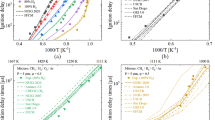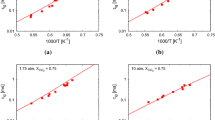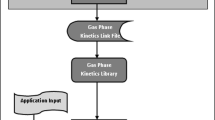Abstract
In order to obtain a reduced methane combustion mechanism for predicting combustion field and pollutants accurately in CFD simulations with a lower computational cost, a reduced mechanism with 22 species and 65 steps of reactions from GRI-Mech 3.0 was obtained by direct relation graph method and sensitivity analysis. The ideal reactor calculation and VV&A (Verification, Validation, and Accreditation) in CFD were carried out using the proposed mechanism. The results showed that the proposed mechanism agrees well with the detailed mechanism in a wide range of operating conditions; the temperature field and species can be predicted accurately in CFD simulations (RANS and LES models), and the NO prediction error of an industrial gas turbine combustor outlet is less than 2×10−6. The proposed mechanism has high engineering values.
Similar content being viewed by others
Abbreviations
- C :
-
the progress variable
- D i,m :
-
the mass diffusion coefficient/m2×s−1
- D T,i :
-
the thermal diffusion coefficient/m−2×s−1
- \({\vec J_i}\) :
-
the diffusion flux
- k :
-
turbulence kinetic energy/m−2×s−2
- p :
-
pressure/Pa
- R ab :
-
the immediate error
- \({\overline S _{ij}}\) :
-
the rate-of-strain tensor
- S Ct :
-
the Schmidt number
- t :
-
time/s
- U :
-
speed/m×s−1
- Y :
-
mass fraction
- α :
-
model parameter
- δ ij :
-
kronecker delta
- ε :
-
the dissipation rate/m2×s−3
- μ :
-
the dynamic viscosity/Pa×s
- μ t :
-
the turbulent viscosity
- ν :
-
the kinematic viscosity/m2×s−1
- ξ :
-
the fine scales
- ρ :
-
density/kg×m−3
- τ :
-
the time scale
- τ ij :
-
the sub grid-scale stress
- ϕ :
-
variable
References
Weber L., International civil aviation organization. Kluwer Law International BV, 2017.
Sung C.J., Wang H., Violi A., Development of comprehensive detailed and reduced reaction mechanisms for syngas and hydrogen combustion. Office of Scientific & Technical Information Technical Reports, 2009.
Hua X., Zhaolin W., Agustin V.M., et al., Study on characteristics of co-firing ammonia/methane fuels under oxygen enriched combustion conditions. Journal of Thermal Science, 2018, 27(03): 78–84.
Peters N., Kee R.J., The computation of stretched laminar methane-air diffusion flames using a reduced four-step mechanism. Combustion and Flame, 1987, 68(1): 17–29.
Dong G., Liu H., Chen Y., General nitrogen-containing semi-detailed chemical kinetic mechanism for methane laminar premixed flame. Journal of Combustion Science and Technology, 2002, 8(1): 44–18.
Zheng Y., Yao Z., Zhu M., Influence of different mechanisms and models on numerical simulation results of gas turbine combustors. Journal of Chinese Society of Power Engineering, 2010, 30(7): 485–190.
Msaad A.A., Belcadi A., Mahdaoui M., et al., Reduced detailed mechanism for methane combustion. Energy and power engineering, 2012, 4(1): 28–33.
GRI-Mech 3.0. http://combustion.berkeley.edu/gri-mech/version30/text30.html, 2019 (accessed on April 10, 2019).
Bulat G., Jones W.P., Marquis A.J., NO and CO formation in an industrial gas-turbine combustion chamber using LES with the Eulerian sub-grid PDF method. Combustion and Flame, 2014, 161(7): 1804–1825.
Gruhlke P., Proch F., Kempf A.M., et al., Prediction of CO and NOx pollutants in a stratified bluff body burner. Journal of Engineering for Gas Turbines and Power, 2018, 140(10).
Deng K., Zhao Y., Fang D., et al., NOx emission from methane jet diffusion flames at different coaxial air flow rates. Journal of Chinese Society of Power Engineering, 2010, 30(11): 874–882.
GRI-Mech 2.11. http://combustion.berkeley.edu/gri-mech/new21/version21/text21.html, 2019 (accessed on April 10, 2019).
Saini R., Prakash S., De A., et al., Investigation of NOx in piloted stabilized methane-air diffusion flames using finite-rate and infinitely-fast chemistry based combustion models. Thermal Science & Engineering Progress, 2018, 5: 144–157.
Barlow R.S., Sandia National Laboratories, TNF workshop website, 2003.
Hao N.T., A chemical reactor network for oxides of nitrogen emission prediction in gas turbine combustor. Journal of Thermal Science, 2014, 23(3): 279–284.
Mallampalli H.P., Fletcher T.H., Chen J.Y., Evaluation of CH4/NOx reduced mechanisms used for modeling lean premixed turbulent combustion of natural gas. Journal of Engineering for Gas Turbines and Power, 1998, 120(4): 703–712.
Hu X., Yu Q., Li Y., et al., A minimal skeletal mechanism for combustion of CH4/O2/CO2 mixtures. Energy & Fuels, 2016, 30(2): 1407–1414.
Chen Y., Chen J.Y., Towards improved automatic chemical kinetic model reduction regarding ignition delays and flame speeds. Combustion and Flame, 2018, 190: 293–301.
Lu T., Law C.K., A directed relation graph method for mechanism reduction. Proceedings of the Combustion Institute, 2005, 30(1): 1333–1341.
Lu T., Law C.K., Linear time reduction of large kinetic mechanisms with directed relation graph: n-heptane and iso-octane. Combustion & Flame, 2006, 144(1): 24–36.
Lu T., Law C.K., On the applicability of directed relation graphs to the reduction of reaction mechanisms. Combustion & Flame, 2006, 146(3): 472–483.
Turányi T., Applications of sensitivity analysis to combustion chemistry. Reliability Engineering & System Safety, 1997, 57(1): 41–48.
Goussis L.A., Lam S.H., Goussis D.A., The CSP method for simplifying kinetics. International Journal of Chemical Kinetics, 2010, 26(4): 461–486.
ANSYS Chemkin-Pro Reaction Workbench User’s Manual.
Xing J., An J., Qiu R., et al., Mechanism reduction of CH4 with principle component analysis. Fire Safety Science, 2009, 18(4): 200–205.
Turns S.R., Introduction to combustion. McGraw-Hill Companies, 1996.
Anonymous, FLUENT 14.5 fluid simulation calculation from entry to proficiency, 2014.
Yang J., FGM based premixed and partially premixed turbulent combustion model—research and application. Graduate School of Chinese Academy of Sciences, Beijing, China, 2012.
Albrecht B.A., Zahirovic S., Bastiaans R.J.M., et al. A premixed flamelet-pdf model for biomass combustion in a grate furnace. Energy & fuels, 2008, 22(3): 1570–1580.
Lin Z., Zhou J., Huang Y., Simplification of detailed reaction mechanism based on the sensitivity analysis and quasi-steady state assumption. Journal of National University of Defense Technology, 2007, 29(1): 1–36.
Barlow R.S., Frank J.H., Effects of turbulence on species mass fractions in methane/air jet flames. Symposium (International) on Combustion. Elsevier, 1998, 27(1): 1087–1095.
Karalus M.F., Fackler K.B., Novosselov I.V, et al., A skeletal mechanism for the reactive flow simulation of methane combustion. Turbo Expo: Power for Land, Sea, and Air. American Society of Mechanical Engineers, San Antonio, USA, 2013, 6: 3–7. DOI: https://doi.org/10.1115/GT2013-95904.
Fuligno L., Micheli D., Poloni C., An integrated approach for optimal design of micro gas turbine combustors. Journal of Thermal Science, 2009, 18(2): 173–184.
Stopper U., Meier W., Sadanandan R., et al., Experimental study of industrial gas turbine flames including quantification of pressure influence on flow field, fuel/air premixing and flame shape. Combustion & Flame, 2013, 160(10): 2103–2118.
Mallouppas G., Goldin G., Zhang Y., et al., Investigation of an industrial gas turbine combustor and pollutant formation using LES. Turbo Expo: Power for Land, Sea, and Air. American Society of Mechanical Engineers, Charlotte, USA, 2017, 6: 26–30. DOI: https://doi.org/10.1115/GT2017-64744.
Jaravel T., Prediction of pollutants in gas turbines using large eddy simulation. The University of Toulouse, Toulouse, France, 2016.
Acknowledgement
This work was supported by National Science and Technology Major Project (2017-III-0006-0031) and Fundamental Research Funds for the Central Universities (3072019CFJ0307). The computational time at Harbin Engineering University Supercomputing Service is gratefully acknowledged.
Author information
Authors and Affiliations
Corresponding author
Rights and permissions
About this article
Cite this article
Sun, J., Zhang, Z., Liu, X. et al. Reduced Methane Combustion Mechanism and Verification, Validation, and Accreditation (VV&A) in CFD for NO Emission Prediction. J. Therm. Sci. 30, 610–623 (2021). https://doi.org/10.1007/s11630-020-1321-3
Received:
Published:
Issue Date:
DOI: https://doi.org/10.1007/s11630-020-1321-3




